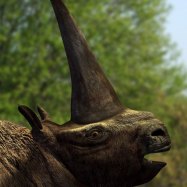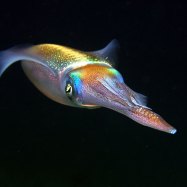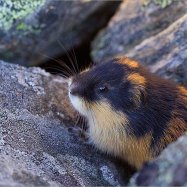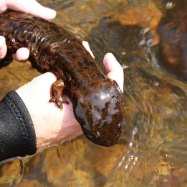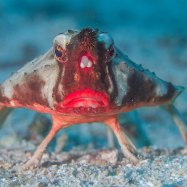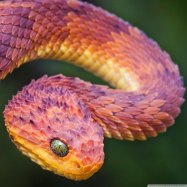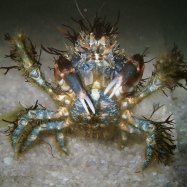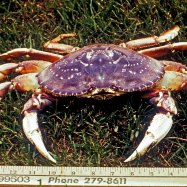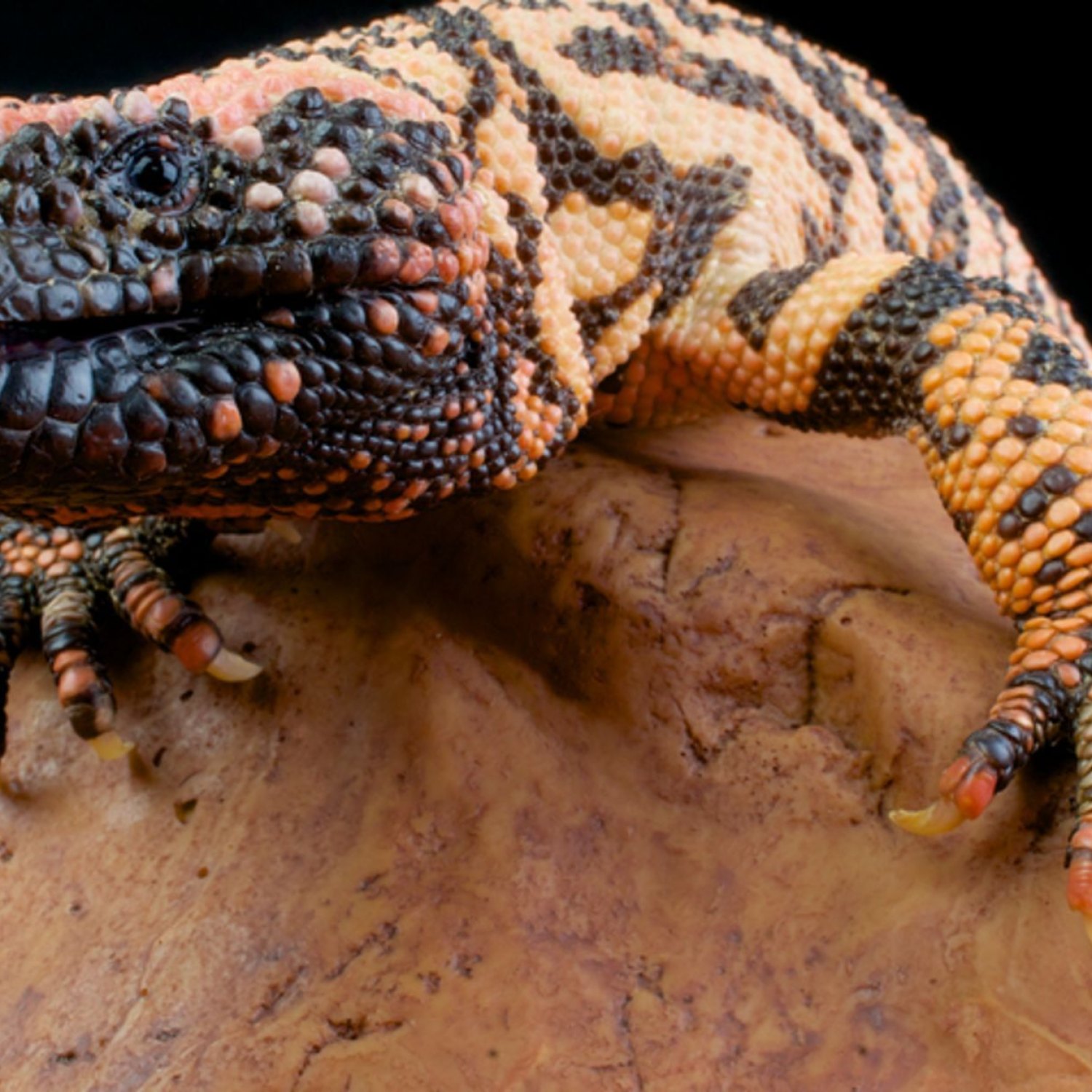
Gila Monster
20-24 inches
The Gila Monster, found in the Sonoran and Mojave Deserts, can grow up to 20-24 inches in length. Known for its short and stout body shape, this member of the Helodermatidae family is a venomous lizard. It gets its name from the Gila River basin, where it was first discovered. #GilaMonster #lizards #desertlife
Animal Details Summary:
Common Name: Gila Monster
Kingdom: Animalia
Habitat: Deserts and scrublands
The Fascinating Gila Monster: A Unique Reptile from the Deserts of United States and Mexico
The Gila Monster, with its striking black body and bold patterns of orange or pink, is a unique reptile found in the deserts of Southwestern United States and northwestern Mexico. Its scientific name, Heloderma suspectum, translates to "studded skin" in Greek, and it is the only venomous lizard native to the United States.This squat and sturdy reptile belongs to the Animalia Kingdom and the Chordata Phylum, which means it is characterized by a notochord and a dorsal nerve cord during its embryonic stage. It is classified under the Squamata Order, also known as the scaled reptiles, and the Helodermatidae Family, which consists of only two species - the Gila Monster and the Mexican beaded lizard Gila Monster.
Let us dive into the world of this fascinating creature and learn more about its habitat, feeding habits, and unique characteristics.
The Habitat and Distribution of Gila Monster
Gila Monsters are primarily found in the Sonoran and Mojave Deserts, which span across the states of Arizona, California, and Nevada in the United States, and the Mexican states of Sonora and Sinaloa. These arid regions are known for their hot and dry climate, and the Gila Monster is adapted to thrive in these harsh conditions.The Gila Monster prefers to live in burrows, which it digs using its strong forelimbs and sharp claws. It can also take shelter under rocks and vegetation or use abandoned burrows of other animals. These solitary creatures are usually active during the day and retreat into their burrows at night to avoid extreme temperatures.
Feeding Habits of the Gila Monster
The Gila Monster is known to be a carnivorous reptile, although studies have shown that it can survive for a year without food. With a slow metabolism and a sedentary lifestyle, this reptile doesn't need to hunt often. However, when it does hunt, it is typically at dawn or dusk Gomphotherium.The Gila Monster feeds on a variety of small prey, including insects, small mammals, birds, eggs, and even other reptiles. Its venom, which is released through its venom glands located in its lower jaw, is used to immobilize its prey. Contrary to popular belief, the Gila Monster does not use its venom to hunt for prey but instead relies on its strong jaws and sharp teeth to hold and crush its prey.
Unique Physical Characteristics of the Gila Monster
The Gila Monster is recognized for its distinctive black body with bold patterns of orange or pink. This unique coloration serves as a warning to predators, as it indicates that the Gila Monster is venomous.But what makes the Gila Monster venomous? Its venom contains a neurotoxin known as helodermin, which affects the nervous system of its prey, causing paralysis and eventually death. Luckily, the Gila Monster's venom is not fatal to humans, but it can cause severe pain and discomfort.
Apart from its venom, the Gila Monster also has several other unique physical characteristics that set it apart from other lizards. Its body shape is short and stout, with a thick tail used to store fat reserves to survive during periods without food. It also has a large head and a wide, powerful jaw with sharp teeth.
On average, the Gila Monster measures around 20 to 24 inches in length, making it one of the larger lizards found in the United States. Its body is covered in smooth, shiny scales, giving it a tough and leathery appearance.
Conservation of the Gila Monster
The Gila Monster is listed as a least concern species by the International Union for Conservation of Nature (IUCN). However, it is protected under the laws of the United States and Mexico, as its population has declined due to habitat loss and human interference.The Gila Monster has a slow reproductive rate, with females laying only 2 to 12 eggs every other year. This means that a population decline can have a significant impact on their numbers. Due to their low numbers, the Gila Monster is considered an indicator species. This means that their presence or absence can indicate the health of their ecosystem.
Conclusion
The Gila Monster may not be as well-known as other lizards, but it is a unique and fascinating creature that is perfectly adapted to its desert habitat. Its venomous nature and bold coloration make it stand out from other lizards, and it plays a crucial role in maintaining the balance of its ecosystem.Despite its venom, the Gila Monster is a shy and elusive reptile that poses no threat to humans unless provoked. As we continue to learn more about this intriguing species, we must also strive to protect and conserve its habitat to ensure its survival for future generations to come.
In conclusion, the Gila Monster is a true marvel of nature, and its beauty and resilience serve as a reminder of the diversity and wonder of the animal kingdom.

Gila Monster
Animal Details Gila Monster - Scientific Name: Heloderma suspectum
- Category: Animals G
- Scientific Name: Heloderma suspectum
- Common Name: Gila Monster
- Kingdom: Animalia
- Phylum: Chordata
- Class: Reptilia
- Order: Squamata
- Family: Helodermatidae
- Habitat: Deserts and scrublands
- Feeding Method: Carnivorous
- Geographical Distribution: Southwestern United States and northwestern Mexico
- Country of Origin: United States and Mexico
- Location: Sonoran and Mojave Deserts
- Animal Coloration: Black with bold patterns of orange or pink
- Body Shape: Short and stout
- Length: 20-24 inches
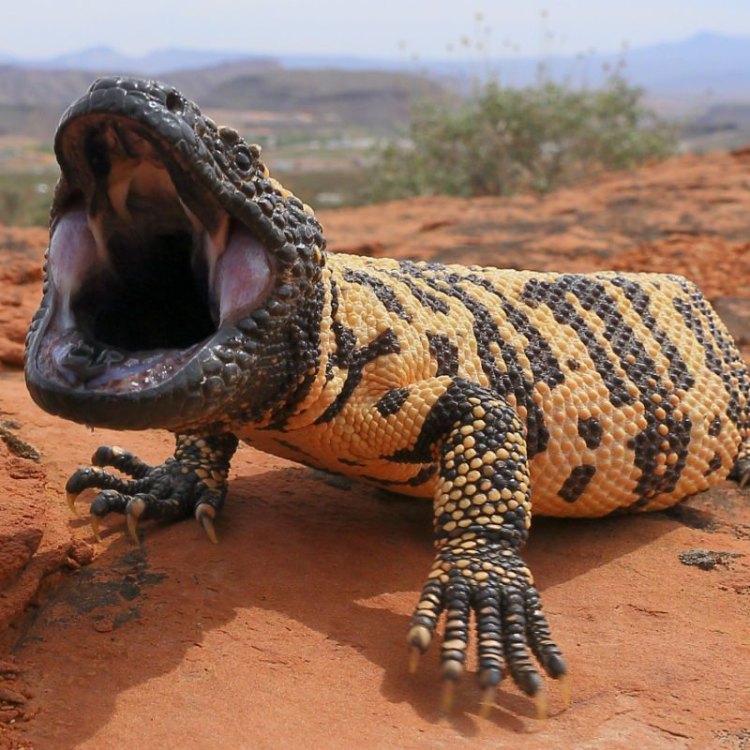
Gila Monster
- Adult Size: 12-14 inches
- Average Lifespan: 20 years
- Reproduction: Sexual
- Reproductive Behavior: Males compete for females
- Sound or Call: Hissing
- Migration Pattern: Not migratory
- Social Groups: Solitary
- Behavior: Mostly nocturnal
- Threats: Habitat destruction and illegal collection
- Conservation Status: Near Threatened
- Impact on Ecosystem: Helps control populations of small mammals and reptiles
- Human Use: None
- Distinctive Features: Venomous bite, unique scale pattern
- Interesting Facts: It is one of only two venomous lizards in the world
- Predator: Birds of prey and larger mammals
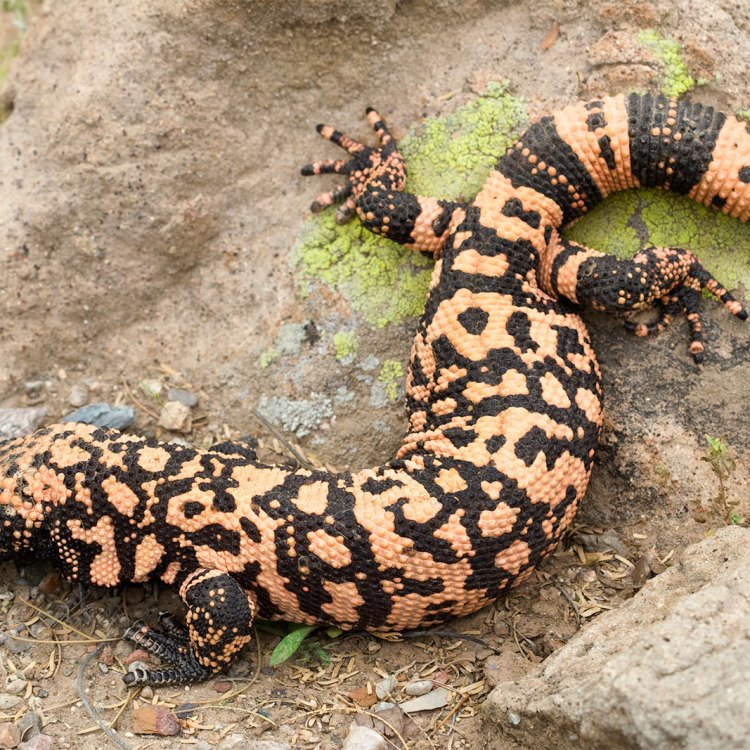
Heloderma suspectum
The Mysterious Gila Monster: A Venomous Lizard of the Desert
The desert is home to many fascinating creatures, each with their unique features and behaviors. One such creature is the Gila Monster (Heloderma suspectum), a venomous lizard found in the southwestern United States and parts of Mexico. This elusive reptile has captured the curiosity of many for its distinctive appearance and venomous bite. In this article, we will delve into the mysterious world of the Gila Monster and discover what makes it an essential part of the desert ecosystem PeaceOfAnimals.Com.Adult Gila Monsters typically grow to be around 12-14 inches long, making them one of the largest lizards in North America. They have a stocky body with a wide head and a short, thick tail. Their skin is covered in beautiful, textured scales that help them blend into their desert surroundings. These scales also serve a more crucial purpose - protecting the Gila Monster from the harsh environment and potential predators.
The average lifespan of a Gila Monster is around 20 years, with some individuals living up to 30 years in captivity. They are known to be slow-moving, which may contribute to their long life span in the wild. However, in captivity, their lifespan is often shorter due to the stress and inadequate care they receive.
Like other reptiles, Gila Monsters reproduce sexually. During the mating season, which typically occurs in the spring, males compete for the attention of females Golden Mole. They engage in a ritual known as the "dance of the Gila," where they bob their heads, hiss, and wrestle with each other. This behavior is not only a competition for dominance but also a way to attract females. Once a female has been chosen, she will lay eggs in a burrow, where they will hatch after 8-9 months.
One of the most distinct features of the Gila Monster is its venomous bite. Their venom is neurotoxic, meaning it affects the nerves, and can cause paralysis or even death. However, despite its dangerous reputation, there have been no recorded deaths from Gila Monster bites in over 100 years. The venom is primarily used for hunting and self-defense against predators.
In terms of communication, Gila Monsters are known to hiss as a warning sound when they feel threatened. This hissing noise is produced by the rapid exhaling of air through their nostrils. It can also be used during the mating season, as males may hiss to attract females.
Unlike other lizards, Gila Monsters are mostly solitary creatures, only coming together to mate. They are also mostly nocturnal, meaning they are most active at night. During the day, they seek shelter from the intense desert heat in burrows or under rocks. At night, they emerge to hunt for prey.
The Gila Monster has no specific migration pattern and is considered a non-migratory species. They are territorial animals and often stay in one area throughout their lives. Their home range can vary from a few acres to several square miles, depending on the availability of food and shelter.
Unfortunately, the Gila Monster's once widespread distribution has become fragmented due to habitat destruction and illegal collection. These reptiles are often sought after by collectors because of their unique appearance, but this practice has led to the decline of their population. In some areas, they are also killed by humans who fear their venomous bite.
As a result, the Gila Monster is listed as "Near Threatened" by the International Union for Conservation of Nature (IUCN). Efforts are being made to protect their habitat and limit illegal collection, but more needs to be done to ensure their survival.
Despite these threats, the Gila Monster is an essential part of the desert ecosystem and plays a crucial role in controlling the populations of small mammals and reptiles. They are efficient predators, feeding on anything from eggs and nestlings to small rodents and lizards. By keeping these populations in check, Gila Monsters help maintain the delicate balance of the desert ecosystem.
Interestingly, the Gila Monster is one of only two venomous lizards in the world, the other being the Mexican Beaded Lizard. These two species are the only lizard species with venom powerful enough to cause significant harm to humans. However, their venom is only used as a last resort, and they will try to flee rather than engage in confrontation.
The distinctive scale pattern of the Gila Monster also makes it a valuable species for research and study. Researchers are still studying the patterns and colors of Gila Monster scales to understand their role in survival and reproduction.
In terms of human use, Gila Monsters have no significant value. Despite their venom, they are not used in traditional medicine, and their meat is considered inedible by most people. They are also not commonly kept as pets due to their specialized care requirements and potential for danger.
In conclusion, the Gila Monster is a mysterious and unique creature, playing a vital role in the desert ecosystem. Their venomous bite and distinctive features may have earned them a fearsome reputation, but they are a vital part of their environment and deserve to be protected. As we continue to learn more about these intriguing reptiles, we must also take steps to preserve their habitat and ensure their continued existence in the wild.
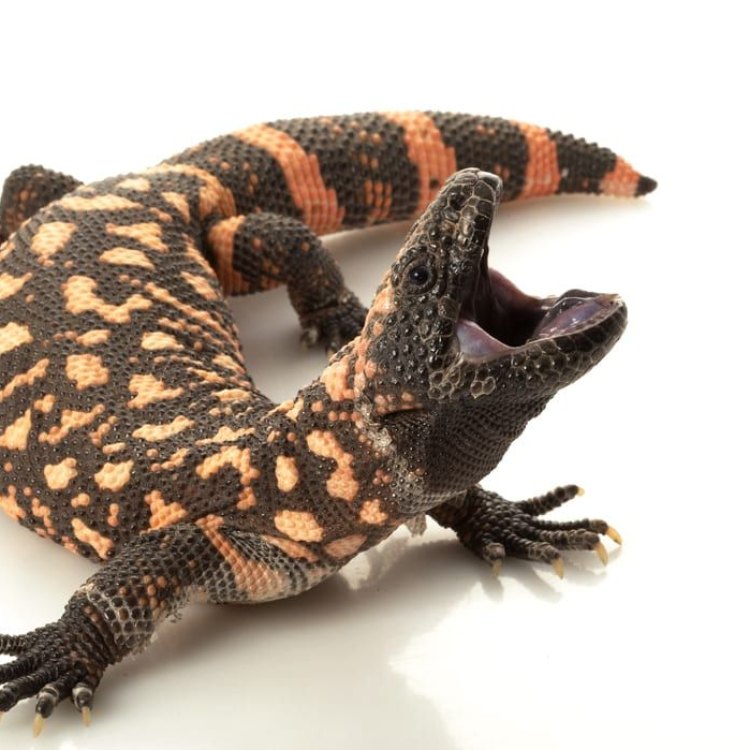
The Fascinating Gila Monster: A Unique Reptile from the Deserts of United States and Mexico
Disclaimer: The content provided is for informational purposes only. We cannot guarantee the accuracy of the information on this page 100%. All information provided here may change without prior notice.

